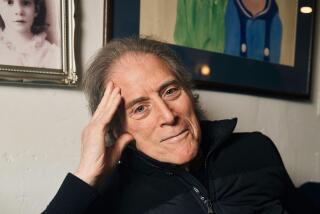Schmeling-Lewis Fight Is One to Relive, Revere
- Share via
On the 28th of September, Max Schmeling celebrated his 99th birthday at home in Hamburg, Germany. A reporter, Florian Kalle, quoted Schmeling as saying that the word “celebrated” is not quite right. “I am getting older,” he said. “It’s not a reason to celebrate.”
He did allow, though, that he has a goal in life. “Now I want to make the 100.”
So, on the 18th of October, go to your television.
Find your PBS station.
Watch The Fight.
You’ll meet Schmeling in 1936, then 30, slick and handsome, a groomed, tailored sophisticate fashioned by Berlin’s cabaret society of the 1920s. The world heavyweight boxing champion from 1930 to ‘32, Schmeling was a national hero who carried German guarantees to the U.S. Olympic Committee that Berlin’s 1936 Olympics would be fair to Jewish athletes, Americans and all others. Later, over lunch, Adolf Hitler thanked Schmeling for helping prevent an Olympic boycott. The Fuhrer gave the fighter an autographed picture of himself. It went up in Schmeling’s study.
You’ll see Joe Louis not as a piece of ancient sports history but vividly alive, 22 years old, rosy youth shimmering on his face, a silent kid up from an Alabama sharecropper’s cotton field. He is not yet the heavyweight champion but already the best fighter in the world. He is not yet, in Jimmy Cannon’s phrase, “a credit to his race, the human race.” He is something less, as the 1930s most famous sports journalist, Paul Gallico, wrote after seeing Louis train:
“I felt myself strongly ridden by the impression that here was a mean man, a truly savage person, a man on whom civilization rested no more securely than a shawl thrown over one’s shoulders, that, in short, here was perhaps for the first time in many generations the perfect prizefighter. I had the feeling that I was in the room with a wild animal.”
They would fight twice, Schmeling and Louis. The PBS film title, The Fight, refers to the second fight because in that one the kid Joe Louis became the icon Joe Louis.
The first time, Louis was undefeated and an 8-1 favorite, only to be knocked down in the fourth round, beaten so badly that his mother ran from the arena crying, “My God, my God, don’t let him kill my child,” and finally knocked out in the 12th.
Poet Langston Hughes expressed the gloom that immediately settled on black Americans: “I walked down Seventh Avenue and saw grown men weeping like children, and women sitting on the curbs with their heads in their hands. All across the country that night when the news came that Joe was knocked out, people cried.”
Though Louis won the heavyweight title the next year, that success felt hollow. He needed the redemption possible only in another fight with Schmeling. By the time of the rematch in the summer of 1938, Hitler was in full war cry. In March, he took Austria. Then he moved against Czechoslovakia. News of the persecution of Jews and suppression of civil liberties in Germany made it easy for fight fans, and everyone else, to see Schmeling as representative of Hitler. Louis, then, took America on his shoulders.
“There’s just something about boxing,” says Barak Goodman, who wrote, produced and directed The Fight. “It’s simple, mano a mano, and it’s quick. The intensity of the action, brief as it is, lends itself to a fervor that draws everyone in.”
To Schmeling’s credit, he did nothing to portray himself as Hitler’s fighter. “This is just another heavyweight fight,” he said. “Of course, Hitler and all Germany is interested ... but sport is sport in Germany -- nothing more.... “
Louis thought it might be more, or his ghostwriter did, anyway. On June 22, 1938, the day of the fight, an article under Louis’ byline read: “Tonight I not only fight the battle of my life to revenge the lone blot on my record, but I fight for America against the challenge of a foreign invader, Max Schmeling. This isn’t just one man against another or Joe Louis boxing Max Schmeling; it is the good old U.S.A. versus Germany.”
The fight lasted 2 minutes and 4 seconds.
From ringside that night, sportswriter Bob Considine began his story, “Listen to this, buddy, for it comes from a guy whose palms are still wet, whose throat is still dry, and whose jaw is still agape from the utter shock of watching Joe Louis knock out Max Schmeling.... Hard brown arms, propelling two unerring fists, blurred beneath the hot white candelabra of the ring lights. And Schmeling was in the path of them, a man caught and mangled in the whirling claws of a mad and feverish machine.”
A long time later, Miami sports columnist Edwin Pope said, “Joe Louis was more than a symbol. He was a walking, living, punching demonstration that a black man could do just about anything he set out to do in this country if he had the goods.”
That fight was the fulcrum on which Joe Louis’s career balanced.
Lose, he’s just another guy.
Win, he’s Joe Louis forever.
Watch The Fight.
You’ll cheer, too.
More to Read
Go beyond the scoreboard
Get the latest on L.A.'s teams in the daily Sports Report newsletter.
You may occasionally receive promotional content from the Los Angeles Times.










